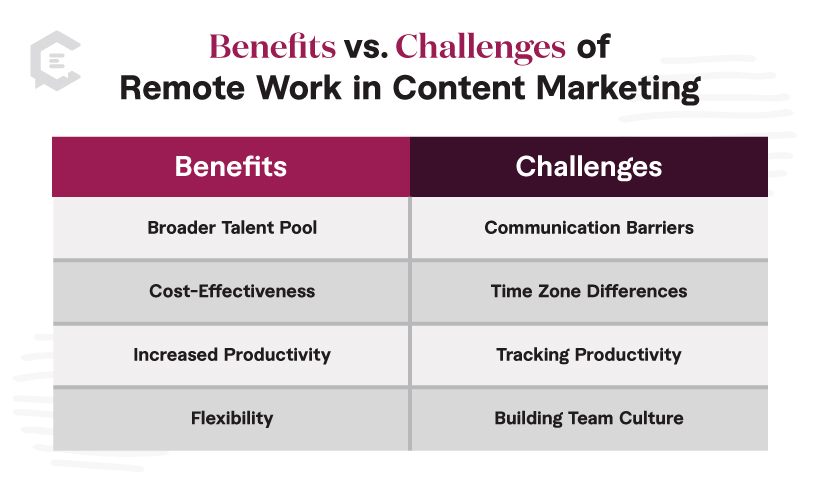No one was ready for the shift to remote work a few years ago. It’s clear now that it’s here to stay.
Managing remote content teams is a delicate balance, but the core remains the same — organizing and motivating employees effectively to drive your content’s performance and success.
In this article, we’ll help you navigate the intricacies of managing remote content teams so you can take full advantage of their potential.
The Current Remote Work Landscape
The shift toward remote/hybrid work has reshaped many companies’ organizational structures. Right now, 98 percent of workers want to work remotely at least some of the time. Not only that, a study last year found that:
- 13 percent of full-time employees were fully remote, and another 30 percent were in a hybrid arrangement
- 28 percent of workdays were worked remotely, a significant increase from 7 percent in 2019
Whether you’re transitioning to a fully remote setup or experimenting with a hybrid model, managing remote content teams brings its own set of benefits and challenges. Let’s dive into them.
The Benefits of Remote Work in Content Marketing
- Broader Talent Pool: Remote work dismantles geographical barriers with workers. That means you can hire the best content creators, strategists, and marketers from anywhere in the world.
- Cost-Effectiveness: Besides saving money on a physical office, outsourcing to freelancers can eliminate overhead costs and full-time benefits packages. You can then reinvest those savings into more critical areas of your strategy.
- Increased Productivity: Your remote content teams can create work environments that suit their individual needs. They can also schedule work during their peak productivity hours to produce higher-quality work more efficiently.
- Flexibility: Employees often cite flexible work arrangements as a key factor in their satisfaction and retention. A study found that remote employees have twice as much work-life balance as full-time employees.
Challenges of Remote Work in Content Marketing
- Communication Barriers: The lack of face-to-face interactions and over-reliance on written communication can sometimes lead to things being misinterpreted or lost in translation.
- Time Zone Differences: Coordinating meetings, aligning deadlines, and collaborating on projects in real time can be difficult when team members work at different times.
- Tracking Productivity: Finding the right balance between trusting employees and ensuring they’re completing their tasks can be tough. There’s an element of dependency on self-motivation and discipline from your remote team members.
- Building Team Culture: Building personal connections with your remote team and fostering a sense of belonging can be hard. Keeping everyone motivated and feeling valued takes intentional effort and creative approaches.
Top 5 Tips for Managing Remote Content Teams
1. Set your expectations clearly and early.
Effectively managing remote content teams starts with crystal-clear expectations. That clarity sets the stage for a smooth workflow and mutual understanding of what’s required.
After onboarding them, define specific goals, responsibilities, and communication practices. That includes setting boundaries for both yourself and them to maintain a healthy work-life balance.
Share the broader vision of the project and your brand, and show them how their work contributes to that vision. It’ll help them understand the big picture and their role in it. Plus, it’ll instill in them some autonomy to make decisions and take ownership of their work when you delegate their responsibilities to them.
2. Establish clear communication channels.
Communication is easy when the members of your content team are all physically at the office. There’s a lot less room for ambiguity, and it’s hard to miss relevant discussions. Obviously, when everybody’s working from home, maintaining these lines of communication is a bit more complicated. Thank god for technology.
Project management and communication tools like Zoom, Slack, and Trello are game-changers in this department. Here’s how you can make the most effective use of them:
- First, ensure everyone has access to and knows how to use the collaborative tools. Remote training is still relatively new to a lot of people. There will be some snags along the way. Be ready to assist with or provide remote training for anyone who needs it.
- It helps to build in weekly check-ins and set times to bounce ideas around to prevent your productivity and creativity from suffering. At ClearVoice, we always start Mondays with a weekly sync to ensure everyone’s on the same page. Then, we have a set time of office hours for anyone who wants to hop in and bat ideas back and forth.
3. Maintain consistency.
Standards and expectations are important, but they won’t mean a thing if they aren’t enforced consistently.
Shifting to work from home means a certain degree of upheaval as work patterns change and people adjust. It can mean corners getting cut, whether deliberately (taking advantage of the extra leeway) or by accident. It’s a natural occurrence as people try to adapt to an unusual set of arrangements.
To maintain consistent productivity across your remote content team, ensure everyone works the same hours and shares the workload equally. It’s also important that there remains a certain boundary between work time and personal time. Everyone needs time away from the grindstone to look after themselves.
For brand consistency, your brand and editorial guidelines are your best friend here. They’ll help you uphold your company’s quality standards and consistency. They’re particularly useful when managing remote content teams since they provide a reference everyone can keep going back to.
4. Don’t micromanage. Trust your team.
Nobody likes to have their manager hanging over their shoulder all the time — remotely or otherwise. As a manager, it’s also completely natural to worry about remote workers slacking when they aren’t being watched. If someone does need close supervision to work properly, it might be time for a change. A truly professional worker should already have enough buy-in to work well under their own steam.
Here are our top tips to help you avoid micromanaging your team:
- Before contacting your colleagues, ask yourself whether you really need to do so. Of course, you want to make yourself reachable and approachable, but a more restrained approach to management can work wonders.
- Don’t be afraid to ask your team members what they think of your approach to management and communication. Make sure you give them the freedom to make constructive criticisms. You might be too overbearing without realizing it.
- Empower your team to take responsibility for themselves. Help them develop their own leadership skills and encourage autonomy. It’ll not only help them reach their full potential, but it also means there’s less pressure on you.
Bottom line, remote working requires a modest leap of faith. By all means, make yourself available and ensure your team can reach you whenever they need. But don’t let micromanagement make your team counterproductive.
5. Encourage close collaboration.
Fostering a strong culture of positivity and collaboration is important in any workplace. It’s especially useful in creative fields like content creation. Collaboration is how ideas go from the bare-bones basics to fully fleshed-out creations. Again, physical distance complicates this (unavoidably). How do you ensure that content teams continue to bounce ideas and insights off one another even when they’re working remotely?
Here’s how:
- Create a sense of shared aims and values. Your leadership sets the tone for the rest of the team. If you lead by example and emphasize the importance of close teamwork, your team will follow suit.
- Break down company silos. It’s one thing to encourage close working within teams, but it’s also easy for individual teams to become closed off and insular. Challenge your content team by encouraging them to proactively reach out and work with other teams or departments.
- Set time aside for remote team-building activities. It’s possible to maintain team spirit when everyone’s working from home. It just requires a concerted effort. Virtual team building exercises (whether it’s playing games or simply sharing a remote cup of tea) can make a big difference to morale.
One last thing — make sure you allow your content team to express and share their ideas when they’re working remotely. Think about setting some time aside for brainstorming sessions. Not only can that prove highly productive in generating new ideas, but it also gives your team a break from the grind and provides a space to experiment and try new things.
Do You Want a Ready-Made Remote Content Team?
Navigating the nuances of managing remote content teams can take a lot of time and energy. Time and energy you could be spending on higher-level strategy.
At ClearVoice, we know how to make managing remote content teams a well-oiled machine. Our customized content teams bring a wealth of experience, skill, and knowledge of remote collaboration dynamics. Talk to us today to get started.







